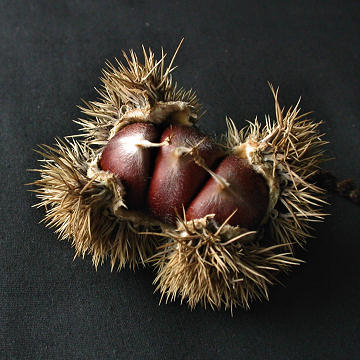
It is fall now and the leaves are just beginning to change. On a recent visit to a local research station I snapped this picture of a softball-sized, spiny fruit of what was likely a hybrid between Chinese Chestnut (Castanea mollissima) and American Chestnut (Castanea dentata). I think it was a hybrid as the leaves did not appear downy underneath (as is typical of Chinese Chestnut) but the spines of the fruit are rather thick (they would be thinner in American Chestnut). If one could go back in time, a little over 100 years ago one would find the forests of the northeast were dominated by the American Chestnut. The smooth, brown seeds found inside these spiny capsules were an important winter food source for early settlers and also for wildlife. Today it is rare to find one of these trees and even rarer to find one that bares fruit.
It took only 50 years following the introduction of Chestnut Blight (Cryphonectria parasitica) to decimate the American Chestnut throughout its range. Virtually all trees were killed back to the ground and only a few survivors exists today as “living stumps”. Occasionally a tree may be found that has obtained sufficient size in order to produce fruit. Trees have been planted outside the native range and are important sources of seed for ongoing research to develop resistance to the disease.
There are two main techniques that researchers are currently using to develop blight-resistant American Chestnut. One is the development of hybrids with Chinese Chestnut, which ironically was the host which carried the blight to North America in the first place. Hybrids are then back-crossed with American Chestnut in an effort to reduce the percentage of Chinese Chestnut traits while maintaining blight resistance. The other technique being utilized is genetic engineering; researchers attempt to add specific genes to provide blight resistance to pure American Chestnut.
Hey Mike! Great to see you have a blog now! Don’t see these down in Jersey much…
Comment by SkekTek — October 8, 2009 @ 09:11
I hope that the efforts to rescue the American Chestnut succeed. How many ative species are we losing to invasive introduced pests?
Comment by Beatriz Moisset — April 20, 2010 @ 12:20
Hi Beatriz. I hope so too. It is difficult to say how many species have been lost due to introduced pests, however many species are being pushed perilous close. American Chestnut, American Elm, Butternut, and our native Ashes have all been decimated by introduced pathogens. Extinction rates are currently occurring at a much faster than the natural background rate, and this has largely been attributed to habitat loss and species introductions. It is particularly serious on islands, where the available habitat for endemic species is quite restricted and many plants and animals have not evolved effective defenses against exotic species.
Comment by Michael Hough — April 22, 2010 @ 18:40
Am I the only one seeing this? There is a full row of Pennsylvania Cherry Blossom trees in full bloom – on Thanksgiving! Don’t believe, I took pics outside a Home store in Providence Town Center, Collegeville PA. Would be glad to share them – just an amateur who loves trees. You can reach me at whalenjohnf@yahoo.com. I’ve never seen this before.
Comment by John Whalen — November 29, 2010 @ 10:01